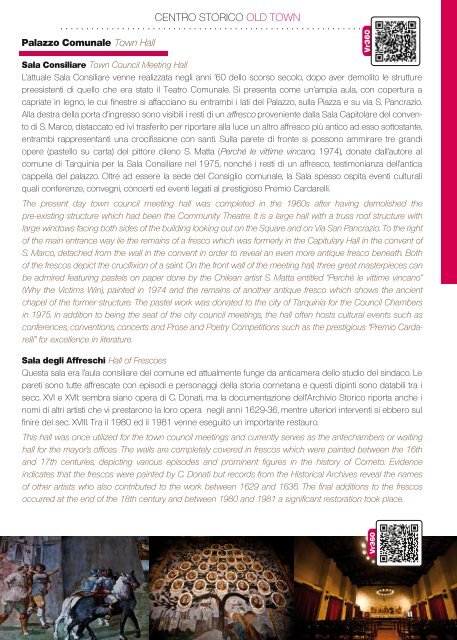Necropoli Etrusca - Tarquinia Resorts
Necropoli Etrusca - Tarquinia Resorts
Necropoli Etrusca - Tarquinia Resorts
You also want an ePaper? Increase the reach of your titles
YUMPU automatically turns print PDFs into web optimized ePapers that Google loves.
Palazzo Comunale Town Hall<br />
CENTRO STORICO OLD TOWN<br />
Sala Consiliare Town Council Meeting Hall<br />
L'attuale Sala Consiliare venne realizzata negli anni '60 dello scorso secolo, dopo aver demolito le strutture<br />
preesistenti di quello che era stato il Teatro Comunale. Si presenta come un'ampia aula, con copertura a<br />
capriate in legno, le cui finestre si affacciano su entrambi i lati del Palazzo, sulla Piazza e su via S. Pancrazio.<br />
Alla destra della porta d'ingresso sono visibili i resti di un affresco proveniente dalla Sala Capitolare del convento<br />
di S. Marco, distaccato ed ivi trasferito per riportare alla luce un altro affresco più antico ad esso sottostante,<br />
entrambi rappresentanti una crocifissione con santi. Sulla parete di fronte si possono ammirare tre grandi<br />
opere (pastello su carta) del pittore cileno S. Matta (Perché le vittime vincano, 1974), donate dall'autore al<br />
comune di <strong>Tarquinia</strong> per la Sala Consiliare nel 1975, nonché i resti di un affresco, testimonianza dell'antica<br />
cappella del palazzo. Oltre ad essere la sede del Consiglio comunale, la Sala spesso ospita eventi culturali<br />
quali conferenze, convegni, concerti ed eventi legati al prestigioso Premio Cardarelli.<br />
The present day town council meeting hall was completed in the 1960s after having demolished the<br />
pre-existing structure which had been the Community Theatre. It is a large hall with a truss roof structure with<br />
large windows facing both sides of the building looking out on the Square and on Via San Pancrazio. To the right<br />
of the main entrance way lie the remains of a fresco which was formerly in the Capitulary Hall in the convent of<br />
S. Marco, detached from the wall in the convent in order to reveal an even more antique fresco beneath. Both<br />
of the frescos depict the crucifixion of a saint. On the front wall of the meeting hall, three great masterpieces can<br />
be admired featuring pastels on paper done by the Chilean artist S. Matta entitled “Perchè le vittime vincano”<br />
(Why the Victims Win), painted in 1974 and the remains of another antique fresco which shows the ancient<br />
chapel of the former structure. The pastel work was donated to the city of <strong>Tarquinia</strong> for the Council Chambers<br />
in 1975. In addition to being the seat of the city council meetings, the hall often hosts cultural events such as<br />
conferences, conventions, concerts and Prose and Poetry Competitions such as the prestigious “Premio Cardarelli”<br />
for excellence in literature.<br />
Sala degli Affreschi Hall of Frescoes<br />
Questa sala era l'aula consiliare del comune ed attualmente funge da anticamera dello studio del sindaco. Le<br />
pareti sono tutte affrescate con episodi e personaggi della storia cornetana e questi dipinti sono databili tra i<br />
secc. XVI e XVII: sembra siano opera di C. Donati, ma la documentazione dell'Archivio Storico riporta anche i<br />
nomi di altri artisti che vi prestarono la loro opera negli anni 1629-36, mentre ulteriori interventi si ebbero sul<br />
finire del sec. XVIII. Tra il 1980 ed il 1981 venne eseguito un importante restauro.<br />
This hall was once utilized for the town council meetings and currently serves as the antechambers or waiting<br />
hall for the mayor’s offices. The walls are completely covered in frescos which were painted between the 16th<br />
and 17th centuries, depicting various episodes and prominent figures in the history of Corneto. Evidence<br />
indicates that the frescos were painted by C. Donati but records from the Historical Archives reveal the names<br />
of other artists who also contributed to the work between 1629 and 1636. The final additions to the frescos<br />
occurred at the end of the 18th century and between 1980 and 1981 a significant restoration took place.<br />
Vr360<br />
Vr360


